The three keys to preventing osteoporosis
Osteoporosis is a disease that results in the thinning of the bones to the point where there is a risk of fracture, and it affects one in two women and one in five men over the age of 50. The most common sites of fracture are the vertebrae of the spine, the wrist, and the top of the thigh bone where it joins the pelvis (neck of the femur).
Our bones are basically a storage site for minerals, and minerals are needed for many functions in the body. For example, calcium is needed in order to be able to contract your muscles. Our body will probably prioritize muscle contraction over bone density so that we can go about our daily activities, and will take calcium from the bones in order to help you contract your muscles, if you do not have enough calcium in the blood.
In order to maintain or increase our bone mass, first and most importantly we need to plug the drain:
- Avoid bread sold in plastic bags, as they usually contain phytates, which drain bones of minerals. Generally baked-goods are risky. Any day without baked goods is likely to be a day where you are gaining bone minerals, and any day that you eat baked goods is likely a day your are losing bone minerals. Simple as that. Home-baked bread that involves a few risings seems to be okay.
- Soak all grains (like rice, rolled or steel-cut oats, quinoi etc.), nuts and seeds for 12 hours, and drain the soak-water to eliminate the phytates before cooking, in order to prevent bone-mineral leaching.
- Stop using stimulants like sugar and caffeine, which results in our bones leaching minerals. (I know. Easier said than done…) Stimulants wreak havoc with our adrenal glands, causing systemic problems in the endocrine system.Systemic stress or anything else that can disrupt endocrine function is hazardous to bones.
- Eating whole food is generally much safer than taking supplements. Supplementing with calcium without knowing one's metabolic type can be risky, as some metabolic types need an acid form (parasympathetic dominants), whereas others need an alkaline form (fast oxidizers) for success, and the catabolic types like slow oxidizers and sympathetic dominants actually have adequate calcium and need the synergistic factors to absorb calcium into their bones. Taking additional calcium will make their situation worse.
Secondly, we need consume the raw materials that our body needs to mineralize our bones in the form of whole food.
- Ensure you are consuming foods that contain calcium, vitamin D, magnesium, cholesterol, saturated fat, protein etc.
- Supplement with K2, trace minerals all year, and Vitamin D3 when you cannot get enough from the sun. (If you are covered in sunscreen, you will not absorb Vitamin D).
- For healthy bones we need a healthy hormonal/endocrine system that is secreting adequate amounts of the enzymes and hormones at the right times and in the right ratios necessary to prevent mineral leaching, and to deposit the minerals into the bone matrix. Find a functional medicine practitioner to get your hormone-system tested, and to move towards hormone balance.
Third, adequate mechanical stress exerted on the bones to make the body realize that it is important to strengthen the bones to be able to handle the mechanical stress. The more kinds of forces applied to the bones, and the more unusual the movement patterns for the bones, the greater the likelihood of increasing bone mass.
- Weight-bearing activity puts a compressive load through the bones.
- Strength training, depending on the nature of the exercise, will put torsion or bending forces through the bones.
- Stretching along the axis of the bones will put tension forces through the bones.
- If you know you have osteoporosis, osteopenia, or have noticed that you are getting shorter, avoid high-impact activity. Running would be a poor exercise choice, for example.
Most people are quite familiar with the importance of good nutrition and quality exercise for improving bone mass, but if we do not have an endocrine system that is functioning optimally, good nutrition and exercise won’t work, as we need our hormones to actually get the minerals into the bones.
Calcitrol is an important hormone that is involved in calcium deposition into bones. The raw material from which calcitrol is made is cholesterol, so it is possible that low cholesterol levels may affect the synthesis of calcitrol.
Cortisol is your stress-response hormone, so if you are suffering from chronic stress, either physical, emotional or spiritual or any combination of the above, or if you are feeling overly fatigued on a daily basis, you may be losing bone mass due to endocrine dysfunction.
It is also well established that corticosteroid drugs, both oral or inhaled, cause a decrease in bone mass just like excess endogenous cortisol does, so if you are on these drugs it may be wise to talk to your doctor about safer alternatives.
If you have been diagnosed with osteoporosis, find a functional medicine doctor or ask your physician to order saliva circadian rhythm adrenal and thyroid hormone tests, and then do whatever is necessary to rectify any issues through functional-medicine protocols and by adjusting lifestyle.
So although osteoporosis, like almost all the degenerative diseases faced by society today, is a complex disease physiologically speaking with a variety of “causesâ€, it can also be viewed as a very simple disease that is caused by living a lifestyle that breaks the laws of nature (eating fake food, inadequate amounts of quality flesh foods, not exercising enough or inappropriate intensity, not enough dark time, and being chronically stressed).
Related Tips
Food, our raw material
Customized Nutrition
Maintain bone mass by preparing grains, nuts and seeds properly
Biochemical Individuality
How steroids, hormones and neurotransmitters work
Thyroid function and dysfunction
High cholesterol does NOT cause heart disease
Reynolds RM et al. Cortisol secretion and rate of bone loss in a population-based cohort of elderly men and women. Calcif Tissue Int. 2005 Sep;77(3):134-8. Epub 2005 Sep 8.
Hubbard R. et al. Use of inhaled corticosteroids and the risk of fracture. Chest. 2006 Oct;130(4):1082-8.
Tauchmanovà L et al. Bone loss determined by quantitative ultrasonometry correlates inversely with disease activity in patients with endogenous glucocorticoid excess due to adrenal mass. Eur J Endocrinol. 2001 Sep;145(3):241-7.
Ledford D. et al. Osteoporosis in the corticosteroid-treated patient with asthma. J Allergy Clin Immunol. 1998 Sep;102(3):353-62.
Mineto M. et al. Bone loss is more severe in primary adrenal than in pituitary-dependent Cushing’s syndrome. Osteoporos Int. 2004 Nov;15(11):855-61. Epub 2004 Mar 18.
Hougardy DM et al. Is enough attention being given to the adverse effects of corticosteroid therapy? J Clin Pharm Ther. 2000 Jun;25(3):227-34.
Yamaguchi T. et al. Plasma lipids and osteoporosis in postmenopausal women. Endocr J. 2002 Apr;49(2):211-7.
Adami S. et al. Relationship between lipids and bone mass in 2 cohorts of healthy women and men. Calcif Tissue Int. 2004 Feb;74(2):136-42. Epub 2003 Dec 15.
Hunt CD et al. Calcium requirements: new estimations for men and women by cross-sectional statistical analyses of calcium balance data from metabolic studies. Am J Clin Nutr. 2007 Oct;86(4):1054-63.
Copyright 2007 / 2019 Vreni Gurd
To subscribe go to
www.wellnesstips.ca
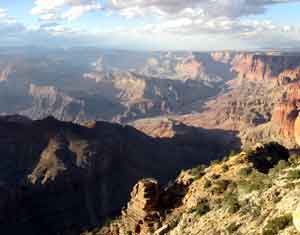 Before leaving on this backpacking trip, it would be accurate to say that I was somewhat apprehensive. It was explained to me that when a trail is described in the trail guide as “exciting” or has “considerable exposure”, that is code for “you are walking along a cliff edge, and a slip here could hurt badly.” The trails that we had committed to were considered “extremely strenuous – for experienced Grand Canyon hikers only”, which of course I was not. And the fact that my quads had still become quite sore after my training hike the week prior to leaving did not inspire much confidence that I was actually ready for the big show. Our plan was to hike north down the Tanner trail from the east end of the Park on south rim to the Colorado River, then continue north along river following the Beamer trail, hopefully to the confluence of the Little Colorado, and then retrace our steps out. Then we would drive around to the wilder north rim, and explore the Nankoweap trail, the so-called most challenging trail in the canyon, for a day or two. I spent so much energy worrying about my readiness for the trip, that I didn’t get excited about what I would experience, until we arrived at the rim.
Before leaving on this backpacking trip, it would be accurate to say that I was somewhat apprehensive. It was explained to me that when a trail is described in the trail guide as “exciting” or has “considerable exposure”, that is code for “you are walking along a cliff edge, and a slip here could hurt badly.” The trails that we had committed to were considered “extremely strenuous – for experienced Grand Canyon hikers only”, which of course I was not. And the fact that my quads had still become quite sore after my training hike the week prior to leaving did not inspire much confidence that I was actually ready for the big show. Our plan was to hike north down the Tanner trail from the east end of the Park on south rim to the Colorado River, then continue north along river following the Beamer trail, hopefully to the confluence of the Little Colorado, and then retrace our steps out. Then we would drive around to the wilder north rim, and explore the Nankoweap trail, the so-called most challenging trail in the canyon, for a day or two. I spent so much energy worrying about my readiness for the trip, that I didn’t get excited about what I would experience, until we arrived at the rim.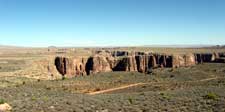 If you didn’t know it was there, you would have no idea by looking out the car window on the drive to the Grand Canyon that it actually existed at all. The land is generally flat, with small stubby trees. Occasionally one would catch a glimpse of a small gorge cut out of the plateau, but nothing to indicate the grandeur that awaited us. Even when the three of us reached the sign for the Grand Canyon National Park, there was no indication that the canyon was so near. We arrived at the south rim mid afternoon Sept. 29th, set up camp in the Desert View campground.
If you didn’t know it was there, you would have no idea by looking out the car window on the drive to the Grand Canyon that it actually existed at all. The land is generally flat, with small stubby trees. Occasionally one would catch a glimpse of a small gorge cut out of the plateau, but nothing to indicate the grandeur that awaited us. Even when the three of us reached the sign for the Grand Canyon National Park, there was no indication that the canyon was so near. We arrived at the south rim mid afternoon Sept. 29th, set up camp in the Desert View campground. 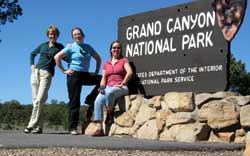 After eating lunch, we walked through the amphitheater of the campground to the rim, and I got my first breathtaking view. WOW! What struck me immediately was the size and beauty of the place. You know how people that have been to the Grand Canyon tell you that it is so big? Well it is SO BIG!!! No photograph can capture the vastness of the place – somehow it is too big for photographs. Not that that stopped us from trying.
After eating lunch, we walked through the amphitheater of the campground to the rim, and I got my first breathtaking view. WOW! What struck me immediately was the size and beauty of the place. You know how people that have been to the Grand Canyon tell you that it is so big? Well it is SO BIG!!! No photograph can capture the vastness of the place – somehow it is too big for photographs. Not that that stopped us from trying. We awoke to thunderstorms the next chilly morning. We were at Lipan Point, at the Tanner trail-head by 7h30am, but thought it best to wait out the storm. I got a great picture of a rainbow over the Canyon, and by 8h30 we headed down the trail through the juniper and pinyon forest. The trail was not nearly as difficult as I thought it would be. Yes, it was steep in places, but there were also long traverses. The path was very obvious the whole way, and I found that contrary to the creek beds that I was hiking on in BC that were
We awoke to thunderstorms the next chilly morning. We were at Lipan Point, at the Tanner trail-head by 7h30am, but thought it best to wait out the storm. I got a great picture of a rainbow over the Canyon, and by 8h30 we headed down the trail through the juniper and pinyon forest. The trail was not nearly as difficult as I thought it would be. Yes, it was steep in places, but there were also long traverses. The path was very obvious the whole way, and I found that contrary to the creek beds that I was hiking on in BC that were  filled with slippery, roly-poly rocks, this trail was made up mostly of broken, sharp scree, so my shoes practically stuck to the trail. There were no scary cliff edges. I imagine they call this trail very strenuous because in the heat of summer there would be no break from the sun, which would wear one down. But, we were hiking in October, and the morning was cloudy. We sat out another thundershower in our rain-gear half way through the morning, but after that the weather cleared into a sunny afternoon.
filled with slippery, roly-poly rocks, this trail was made up mostly of broken, sharp scree, so my shoes practically stuck to the trail. There were no scary cliff edges. I imagine they call this trail very strenuous because in the heat of summer there would be no break from the sun, which would wear one down. But, we were hiking in October, and the morning was cloudy. We sat out another thundershower in our rain-gear half way through the morning, but after that the weather cleared into a sunny afternoon.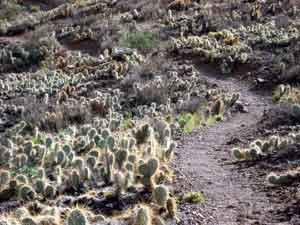 The scenery was simply beautiful. Not only the cliff faces all around us, but also the huge red boulders that dotted the landscape, the black, twisted tree trunks, the cacti, the colour of the soil, which kept changing depending upon what layer of history we were traversing. Even the rocks and small stones were crazy beautiful. You know those rock halves one can buy in gift shops where one side is a collection of crystals? Well, these kinds of rocks were lying on the path! I couldn’t believe what I was seeing. We got to the river about 5h30, set up camp, heated water to pour into our dinner bags, ate, and were in our sleeping bags by 6h30 or 6h45 because it was dark, and there wasn’t anything else to do.
The scenery was simply beautiful. Not only the cliff faces all around us, but also the huge red boulders that dotted the landscape, the black, twisted tree trunks, the cacti, the colour of the soil, which kept changing depending upon what layer of history we were traversing. Even the rocks and small stones were crazy beautiful. You know those rock halves one can buy in gift shops where one side is a collection of crystals? Well, these kinds of rocks were lying on the path! I couldn’t believe what I was seeing. We got to the river about 5h30, set up camp, heated water to pour into our dinner bags, ate, and were in our sleeping bags by 6h30 or 6h45 because it was dark, and there wasn’t anything else to do. The next day we packed up camp and were on the Beamer trail by 8h30. The trail did not stay low, but rather climbed the cliffs above the river, and involved much going in and out of drainages. This trail was not as obvious, and since one in our party was French Canadian, we were looking for “inukshuks” rather than “cairns”. At about 1 o’clock, we came to a beautiful beach on the Colorado, which became our home for the next two days. It was hot, and we stripped out of our funny-looking safari outfits
The next day we packed up camp and were on the Beamer trail by 8h30. The trail did not stay low, but rather climbed the cliffs above the river, and involved much going in and out of drainages. This trail was not as obvious, and since one in our party was French Canadian, we were looking for “inukshuks” rather than “cairns”. At about 1 o’clock, we came to a beautiful beach on the Colorado, which became our home for the next two days. It was hot, and we stripped out of our funny-looking safari outfits  (we hiked in long pants and long-sleeve shirts to protect us from the vicious cacti, agave, and other thorny vegetation, as well as to protect us from the burning rays of the sun.) and into shorts and T-shirts, and spent a splendid afternoon wading in the ice cold water, doing laundry, and playing in the sand and mud. River rafters joined us on our beach that evening, and offered us food and wine – having already eaten, we enjoyed their wine.
(we hiked in long pants and long-sleeve shirts to protect us from the vicious cacti, agave, and other thorny vegetation, as well as to protect us from the burning rays of the sun.) and into shorts and T-shirts, and spent a splendid afternoon wading in the ice cold water, doing laundry, and playing in the sand and mud. River rafters joined us on our beach that evening, and offered us food and wine – having already eaten, we enjoyed their wine.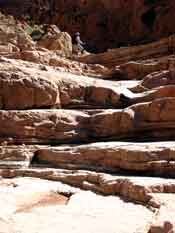 The following day our hope was to make it to the confluence of the Little Colorado. The guidebooks said the trip was long, so we set out early with light packs filled only with food and water. Once again, the trail climbed above the river 50 to 100 feet, and zigzagged in and out of drainages. The drainages looked like big red-rock amphitheatres, complete with a stage and seating, and they were usually shady. I was developing a hot-spot on one of my toes, so we had a shoe-off break so I could apply moleskin. Shoe-off breaks in the shade became a treat. Such a pleasure to be able to wiggle one’s toes around!
The following day our hope was to make it to the confluence of the Little Colorado. The guidebooks said the trip was long, so we set out early with light packs filled only with food and water. Once again, the trail climbed above the river 50 to 100 feet, and zigzagged in and out of drainages. The drainages looked like big red-rock amphitheatres, complete with a stage and seating, and they were usually shady. I was developing a hot-spot on one of my toes, so we had a shoe-off break so I could apply moleskin. Shoe-off breaks in the shade became a treat. Such a pleasure to be able to wiggle one’s toes around!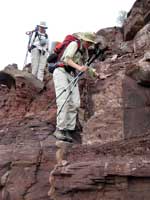 We had just come out of another drainage and were rounding a butte above the river, when we saw that the trail ahead of us was right along the edge of the cliff. SCARY! And this bit seemed long! We were stopped in our tracks, not sure what to do. Going forward seemed too dangerous to be worth while, going back seemed to be a shame, so we decided to try and find another way around the butte and meet up with the trail at the next drainage. So we climbed up and over the gently sloping butte, and after picking our way down the drainage, re-found the trail. I’m not sure how long our waffling indecision and detour took, but probably at least an hour. So, we were forced to turn around by about 1 without having reached the confluence, so that we would make it back to our beach before dark. We didn’t want to be walking on the edge of cliffs in the dark!
We had just come out of another drainage and were rounding a butte above the river, when we saw that the trail ahead of us was right along the edge of the cliff. SCARY! And this bit seemed long! We were stopped in our tracks, not sure what to do. Going forward seemed too dangerous to be worth while, going back seemed to be a shame, so we decided to try and find another way around the butte and meet up with the trail at the next drainage. So we climbed up and over the gently sloping butte, and after picking our way down the drainage, re-found the trail. I’m not sure how long our waffling indecision and detour took, but probably at least an hour. So, we were forced to turn around by about 1 without having reached the confluence, so that we would make it back to our beach before dark. We didn’t want to be walking on the edge of cliffs in the dark!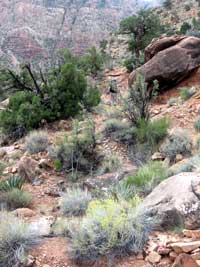 The following morning we packed up our tents, loaded our packs with filtered Colorado River water, said a regretful goodbye to our lovely beach, and headed back the way we came to Tanner beach, and then up the Tanner trail to Cardenas butte where we were to camp for the night. After dinner I was regretting that I had not packed sandals on this trip, as I was dying to get my hiking shoes off my feet. My fellow trekkers suggested that I take the insoles out of my shoes and put them in my socks! Brilliant idea! My toes were free! I loved my slippers!
The following morning we packed up our tents, loaded our packs with filtered Colorado River water, said a regretful goodbye to our lovely beach, and headed back the way we came to Tanner beach, and then up the Tanner trail to Cardenas butte where we were to camp for the night. After dinner I was regretting that I had not packed sandals on this trip, as I was dying to get my hiking shoes off my feet. My fellow trekkers suggested that I take the insoles out of my shoes and put them in my socks! Brilliant idea! My toes were free! I loved my slippers! 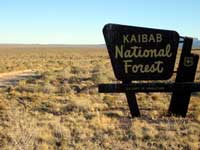 Driving to the Nankoweap trail-head on the north rim, we came across a big sign stating that we were entering the Kaibab National Forest, which I found to be particularly funny, as there was not a tree to be seen. Only open land with sage brush. Finally we got to the end of the dirt road, and we repacked our backpacks for the trek to the trail-head. They were predicting snow that night, and a low of 23 degrees, so we attached an extra fleece blanket each to our packs before heading off through what was looking more and more like that North Kaibab forest that the sign had announced. Two hours later we reached the rim, just before sunset. And yes, it was cold! We were decked out in our warmest clothes and jumping around in the dark and singing songs trying to get warm before slipping into our sleeping bags.
Driving to the Nankoweap trail-head on the north rim, we came across a big sign stating that we were entering the Kaibab National Forest, which I found to be particularly funny, as there was not a tree to be seen. Only open land with sage brush. Finally we got to the end of the dirt road, and we repacked our backpacks for the trek to the trail-head. They were predicting snow that night, and a low of 23 degrees, so we attached an extra fleece blanket each to our packs before heading off through what was looking more and more like that North Kaibab forest that the sign had announced. Two hours later we reached the rim, just before sunset. And yes, it was cold! We were decked out in our warmest clothes and jumping around in the dark and singing songs trying to get warm before slipping into our sleeping bags. We did not wake up to snow, thankfully, but it was definitely chilly. We ate our ziploc bag breakfasts overlooking the north rim and into the beautiful Nankoweap creek basin, and did not take off too many clothes before setting out on our day hike to Marion Point. This trail was very different from the other two we had done – it was very narrow and overgrown in places, different vegetation and a lot more of it, and footing was tricky in places, but it was also breathtakingly beautiful. This was the day that I had fretted the most over before leaving, as there is the famous scary bit where one is stuck between a rock wall and a cliff edge on the way to Marion Point. Falling there would mean certain death. I had decided to take a wait and see attitude, not being sure I would be able to coax myself to do it. But when we got there, somehow it was no problem, even though the path was only about 4 inches wide at the narrowest, and right at that narrow point was a big boulder that stuck out, which meant to pass it we had to turn in to face the cliff. I certainly didn’t enjoy walking that particular 15 feet, but we all managed it twice, as we had to take the same trail back. I honestly think that had we not done the Tanner and the Beamer first, I would not have made it past that point.
We did not wake up to snow, thankfully, but it was definitely chilly. We ate our ziploc bag breakfasts overlooking the north rim and into the beautiful Nankoweap creek basin, and did not take off too many clothes before setting out on our day hike to Marion Point. This trail was very different from the other two we had done – it was very narrow and overgrown in places, different vegetation and a lot more of it, and footing was tricky in places, but it was also breathtakingly beautiful. This was the day that I had fretted the most over before leaving, as there is the famous scary bit where one is stuck between a rock wall and a cliff edge on the way to Marion Point. Falling there would mean certain death. I had decided to take a wait and see attitude, not being sure I would be able to coax myself to do it. But when we got there, somehow it was no problem, even though the path was only about 4 inches wide at the narrowest, and right at that narrow point was a big boulder that stuck out, which meant to pass it we had to turn in to face the cliff. I certainly didn’t enjoy walking that particular 15 feet, but we all managed it twice, as we had to take the same trail back. I honestly think that had we not done the Tanner and the Beamer first, I would not have made it past that point.  The little bit of the Nankoweap that we saw was wild and beautiful, and so unlike the Tanner of the south rim, and the Beamer along the river. Perhaps because the north rim is 1000 feet higher? Perhaps because it falls more steeply to the river? I don’t know. But I can now understand why people who hike the trails are seduced by the Grand Canyon, and yearn to go back. With each trail being so different, affording different kinds of beautiful vistas, it is hard to be satisfied with just hiking one, or two, or three. Let’s just go a little bit further to see what is around the bend …
The little bit of the Nankoweap that we saw was wild and beautiful, and so unlike the Tanner of the south rim, and the Beamer along the river. Perhaps because the north rim is 1000 feet higher? Perhaps because it falls more steeply to the river? I don’t know. But I can now understand why people who hike the trails are seduced by the Grand Canyon, and yearn to go back. With each trail being so different, affording different kinds of beautiful vistas, it is hard to be satisfied with just hiking one, or two, or three. Let’s just go a little bit further to see what is around the bend … Facebook Wellness-Tips Page
Facebook Wellness-Tips Page